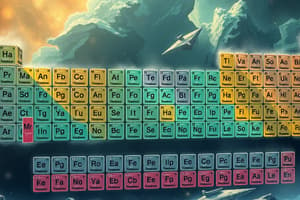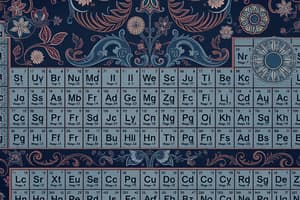Podcast
Questions and Answers
Which group of elements is known for being highly reactive nonmetals?
Which group of elements is known for being highly reactive nonmetals?
- Transition metals
- Halogens (correct)
- Alkali metals
- Noble gases
What characteristic distinguishes metalloids from metals and nonmetals?
What characteristic distinguishes metalloids from metals and nonmetals?
- All are solid at room temperature
- Located exclusively in Group 2 of the periodic table
- Higher density compared to nonmetals
- Ability to conduct electricity only at high temperatures (correct)
Which of the following elements is classified as an alkaline earth metal?
Which of the following elements is classified as an alkaline earth metal?
- Iron
- Potassium
- Fluorine
- Barium (correct)
What is a primary reason that understanding isotopes is significant?
What is a primary reason that understanding isotopes is significant?
Which aspect of the periodic table is highlighted when discussing its predictive capabilities?
Which aspect of the periodic table is highlighted when discussing its predictive capabilities?
What is the primary basis for the organization of the elements in the periodic table?
What is the primary basis for the organization of the elements in the periodic table?
Which of the following statements regarding the periodic table is correct?
Which of the following statements regarding the periodic table is correct?
How did Mendeleev's periodic table predict the existence of undiscovered elements?
How did Mendeleev's periodic table predict the existence of undiscovered elements?
What trend is observed in the atomic radius as one moves across a period from left to right?
What trend is observed in the atomic radius as one moves across a period from left to right?
What characterizes the elements classified as nonmetals?
What characterizes the elements classified as nonmetals?
What happens to the ionization energy as one moves down a group in the periodic table?
What happens to the ionization energy as one moves down a group in the periodic table?
In which group are the alkali metals found, and what is a key property of these metals?
In which group are the alkali metals found, and what is a key property of these metals?
Which of the following trends regarding electronegativity is accurate?
Which of the following trends regarding electronegativity is accurate?
Flashcards
Periodic Table Creator
Periodic Table Creator
Dmitri Mendeleev created the first periodic table in 1869.
Periodic Table Arrangement
Periodic Table Arrangement
Elements are arranged by increasing atomic weight and recurring properties in rows (periods) and columns (groups).
Periodic Table Groups
Periodic Table Groups
Elements in the same group share similar chemical properties due to similar valence electrons, and are labeled by number.
Atomic Number
Atomic Number
Signup and view all the flashcards
Atomic Mass
Atomic Mass
Signup and view all the flashcards
Metal Properties
Metal Properties
Signup and view all the flashcards
Nonmetal Properties
Nonmetal Properties
Signup and view all the flashcards
Metalloid Properties
Metalloid Properties
Signup and view all the flashcards
Group 1 Elements
Group 1 Elements
Signup and view all the flashcards
Group 17 Elements
Group 17 Elements
Signup and view all the flashcards
Isotopes Same, Different
Isotopes Same, Different
Signup and view all the flashcards
Periodic Table's Importance
Periodic Table's Importance
Signup and view all the flashcards
Study Notes
History of the Periodic Table
- Dmitri Mendeleev is credited with creating the first periodic table in 1869.
- He arranged elements by increasing atomic weight and noticed recurring properties.
- His table predicted the existence and properties of undiscovered elements, a significant strength.
- Subsequent discoveries and refinements, driven by the understanding of atomic structure, led to modifications of the table.
Organization of the Periodic Table
- Elements are arranged in rows (periods) and columns (groups or families).
- Each period represents a new energy level for electron shells.
- Elements in the same group share similar chemical properties due to their valence electron configurations.
- Groups are labeled with Roman numerals (IA, IIA, etc.) or more modern notations (1, 2, etc.) based on the valence electron numbers of the elements in the group.
Characteristics of Elements:
- Metals: Located on the left side and center of the table.
- Generally, good conductors of heat and electricity.
- Often shiny and malleable (can be hammered into sheets).
- Tend to lose electrons in chemical reactions.
- Nonmetals: Located on the right side of the table, excluding groups 1 and 2.
- Poor conductors of heat and electricity.
- Can be solids, liquids, or gases.
- Tend to gain electrons in chemical reactions.
- Metalloids (Semi-metals): Located along the stair-step line.
- Exhibit properties of both metals and nonmetals.
- Often used as semiconductors in electronics.
Atomic Number and Atomic Mass
- Atomic number is the number of protons in the nucleus of an atom.
- It determines the element's identity.
- Atomic mass (or atomic weight) is the average mass of an element's isotopes.
- Mass numbers are also used; these are numbers associated with a particular isotope.
Trends in Periodic Properties
- Atomic radius: Generally decreases across a period (due to increasing nuclear charge pulling electrons closer) and increases down a group (due to increasing electron shells).
- Ionization energy: The energy required to remove an electron. Generally increases across a period and decreases down a group.
- Electron affinity: The energy change when an electron is added to an atom. Generally increases across a period (except for noble gases) and decreases down a group.
- Electronegativity: The ability of an atom to attract electrons in a chemical bond. Generally increases across a period and decreases down a group.
Different Classifications of Elements
- Alkali metals (Group 1): Highly reactive metals.
- Alkaline earth metals (Group 2): Reactive metals.
- Transition metals (Groups 3-12): Diverse properties, often form colorful compounds.
- Metalloids: Border the stair-step line; properties intermediate between metals and nonmetals.
- Nonmetals (Groups 14-18): Poor conductors, often gases or brittle solids.
- Halogens (Group 17): Highly reactive nonmetals.
- Noble gases (Group 18): Generally unreactive, inert elements.
Isotopes:
- Atoms of the same element containing the same number of protons and a different number of neutrons.
- Isotopes have similar chemical properties but different atomic masses.
- Understanding isotopes is important for applications like nuclear medicine and power generation.
Importance of the Periodic Table:
- Organized arrangement of known elements.
- Predictive tool for the properties of both known and hypothesized elements.
- Fundamental framework for understanding chemical reactions.
- Crucial for various scientific disciplines.
Modern Periodic Table Variations:
- Various table formats exist, some with specialized arrangements.
- Table illustrations exist with multiple groupings, showing different emphasis.
- This reflects the different nuances of chemical properties and interactions of elements.
Studying That Suits You
Use AI to generate personalized quizzes and flashcards to suit your learning preferences.




